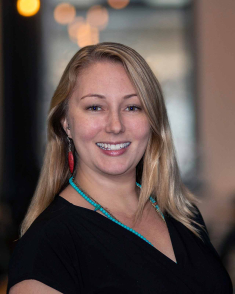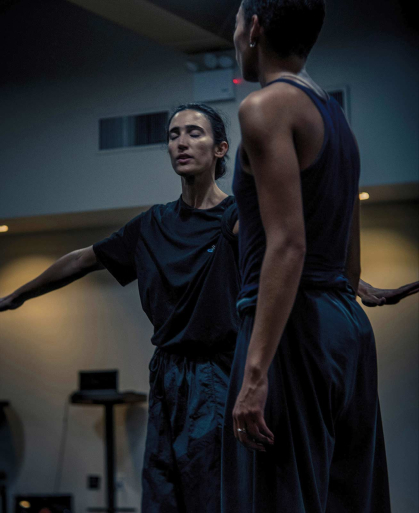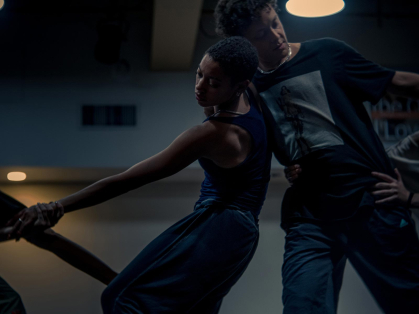Astrophysicist Teams Up With Choreographer to Create Dance Performance Premiering in New York

Rutgers professor says “Birth + Carnage,” which runs from Dec. 19 to Dec. 21, uses computational simulations of star formation as a choreographic framework
What happens when a Rutgers astrophysicist befriends a dance choreographer from New York?
Why, they put on a show.

Blakesley Burkhart, an associate professor with the Department of Physics and Astronomy in the School of Arts and Sciences at Rutgers University-New Brunswick, and choreographer and dancer Marla Phelan cocreated Birth + Carnage, premiering at La MaMa Experimental Theatre Club’s Ellen Stewart Theatre in New York from Dec. 19 to Dec. 21.
Burkhart said Birth + Carnage “lives at the intersection of choreography and astrophysics,” adding that the dance performance thematically links birth, or star formation, and carnage, or stellar feedback and disruption, to the emotional arcs of human relationships.
“Astrophysical data and numerical simulations inspired large-scale digital projections that shift and evolve like living cosmic fields,” Burkhart said. “Dancers move through these projected simulations, creating a feedback loop between motion and meaning.”
Phelan said she and Burkhart participated in a nine-month residency program in New York called Open Interval through the Simons Foundation and Gibney Center in 2022.

“We bonded over the mysteries of the universe and discovered that there were many commonalities between the astrophysics of star formation and the physics of the body in motion,” Phelan said. “The real ‘aha’ moment that sparked the creation of Birth + Carnage was when Blakesley introduced me to N-body simulations of gravity. I transposed the topography and energy of those simulations onto dancers, but because dancers are not inanimate objects flying around in space, I replaced the force of gravity with the force of love or attraction. This led to a unique choreographic process that physically and emotionally mirrors the dynamic systems of stellar birth.”
Burkhart, who is affiliated with the Flatiron Institute at the Simons Foundation in New York, discusses Birth + Carnage, her research and why science needs imagination.
Between studying star-forming clouds and teaching astrophysics, when did you find time to co-create Birth + Carnage?
It happened over several years. Marla and I stay in constant contact and meet regularly. For me, science and art feed different parts of the same curiosity, so working on this project never felt separate from my research. It was just another way to explore the universe.
What compelled you and Phelan to merge choreography with astrophysics?
Both of us were fascinated by the patterns of creation and destruction that repeat across scales – from galaxies to human life. In my research, I study how turbulence shapes stars. Marla studies how movement expresses emotion. Birth + Carnage grew out of realizing those patterns are universal – birth and collapse, chaos and order, energy and stillness.

Many people see science and art as opposites – one rational, the other emotional. Do you find hidden connections between them?
Absolutely. Both are ways of making sense of mystery. In science, we look for the underlying structure in complexity. In art, we feel it. They use different languages, but both arise from the same impulse to understand and express the world around us.
How does this performance tie into your research at Rutgers?
My research focuses on turbulence and star formation – how energy and matter flow through interstellar gas to create new stars. Birth + Carnage encapsulates that process through movement and dynamics. It invites people to feel the physics – the chaos, pressure and beauty of stellar birth – and connects the science to a deeply human process of creation.
What inspired you to pursue a career in astrophysics?
I’ve always been drawn to big questions – how the universe works and why we exist within it. I love the process of research and the ability to discover new aspects about the universe. I also love working with students. I feel extremely fortunate to be a professional astrophysicist and to be here at Rutgers.

What advice do you give to students who are interested in astrophysics?
Stay curious and don’t be afraid to ask the questions that feel too big. Learn math and programming, but also nurture creativity. It will help you see patterns others miss. Science needs imagination and creativity every bit as much as analytic and mathematical thinking.
Are you arranging for Rutgers students to see the performance? Are there plans to bring it to campus?
I’m organizing a Rutgers student trip to the New York performance. Rutgers students are also involved in some promotional events connecting the public in New York City with science via telescope viewings in Madison Square Park and at the Ellen Steward Theatre. We’re also in early discussions about bringing Birth + Carnage to Rutgers or New Brunswick, where it could be paired with talks and workshops exploring art-science collaboration.
Kitta MacPherson contributed to this article.


